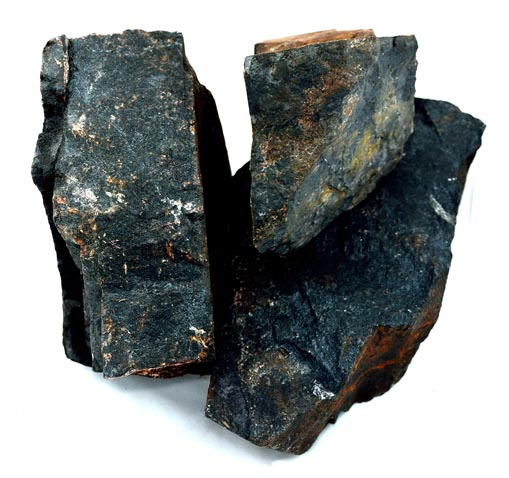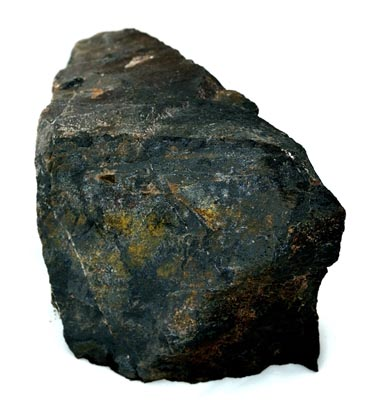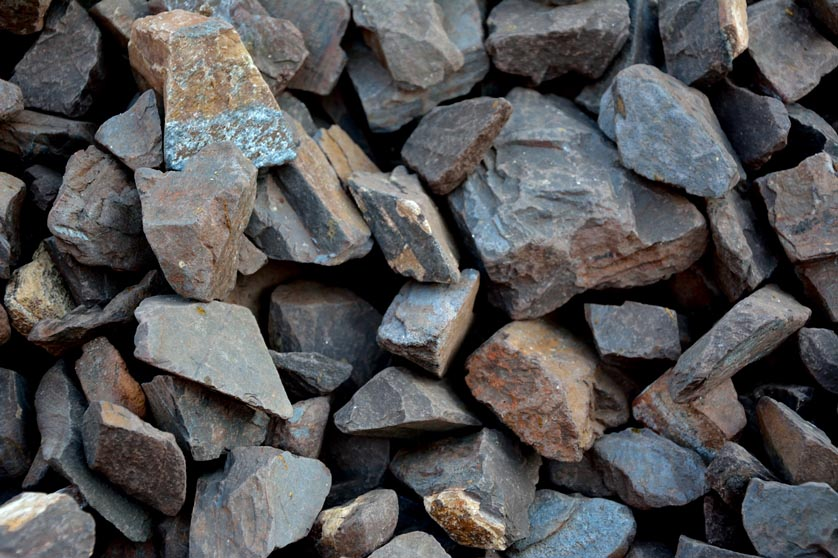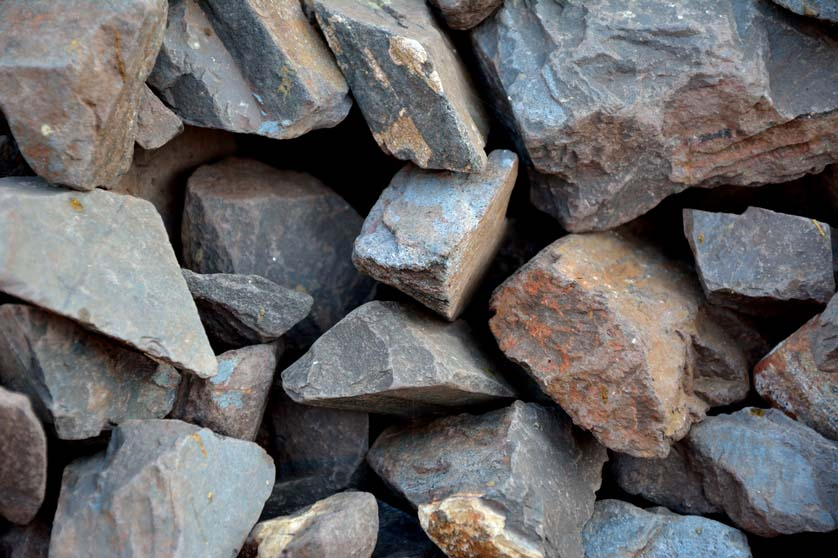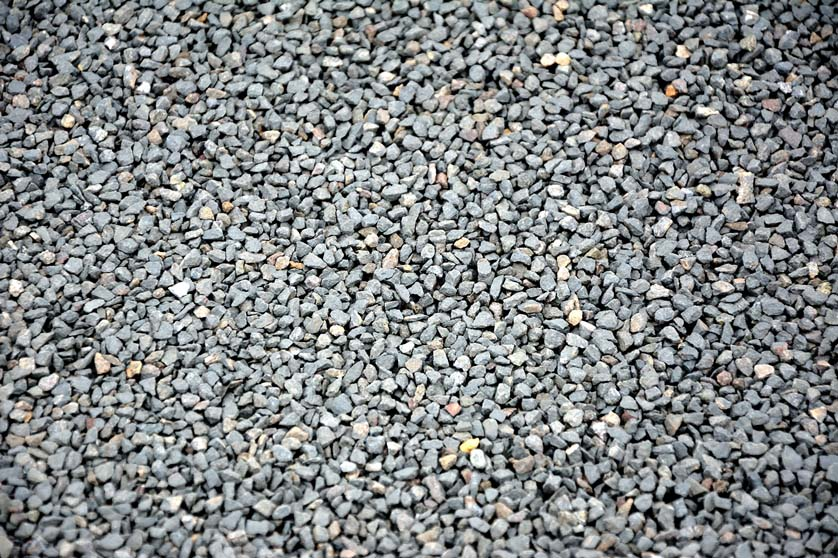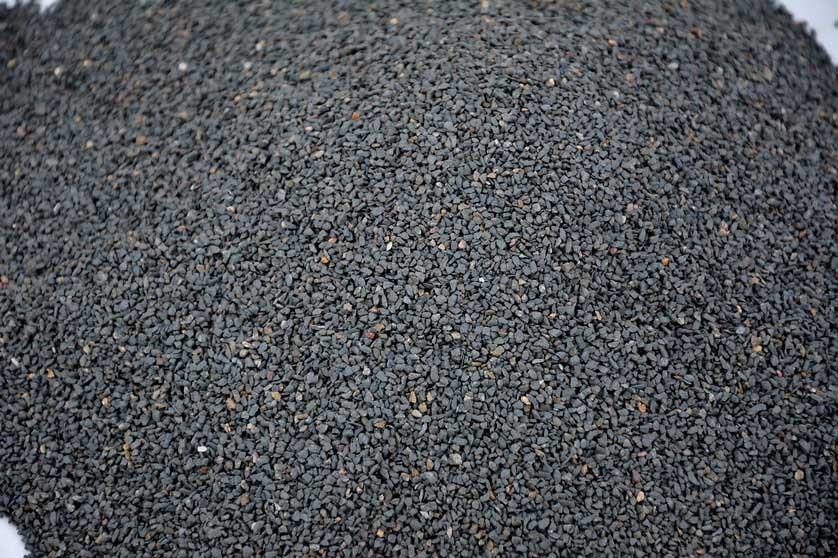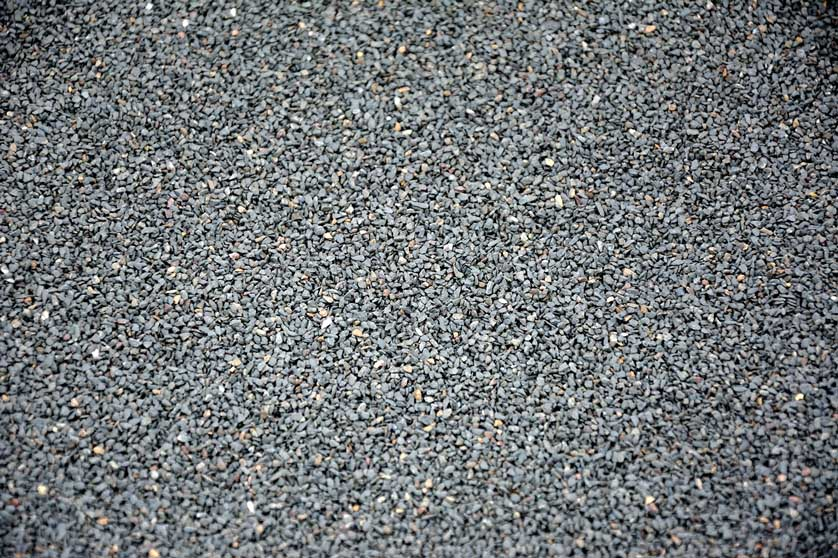Emery (Corundum)
Emery is a kind of rock in granular form, black or dark grey in color and mostly used for the production of abrasive powder. The Word emery is referring EMERI Cape in Naxos Island /Greece where this mineral has first started to be consumed by human
The major part of the emery consists of corundum (aluminum oxide) and trace amounts of iron bearing spinels, hernisite, magnesite and rutile (titanium mineral). Emery used in industry may contain synthetic additives namely magnesium, mullite and silica.
Emery in black or dark grey in color. Specific gravity of the mineral is approximately 3,5-3,8. This fluctuation in specific gravity arouses from the abundance of side-minerals. Due to the same reason MOHS hardness of emery may change. Although the MOHS hardness of corundum is 9, it may drop to 8 because of iron bearing spinels and sometimes even to 6 because of soft minerals such as magnesia in the structure.
Naturally comminuted emery (known as black sand) is used as abrasive material for ages. It may be adhered to plates or paper. It may also be mixed to tarmac in order to increase traction and to harden the road surface. Mixing the emery with tarmac is frequently preferred in Northern America and Europe where it is essential to elongate the service life of tarmac on roads such as bridge tops, critical roads and crossroads.
Emery grains can be used in cutting process of water jets. Generally, garnet is the material used in water jet machines but emery being another natural material may easily replace the garnet in this process. Emery grains grinded to the required size is being used in place of garnet.
Emery grains may be used as a raw material in production of grinding and cut off discs, after passing through some necessary processes. Currently most widely consumed material for this purpose is Brown Fused Alumina which is made by sinterization of bauxite. The hardness level of sinterized bauxite is close to the hardness of emery. The crystal formation of bauxite changes during sinterization and corundum crystals start to form and the hardness level increases due to this formation. On the other hand, emery is a natural material already having these features. Therefore, it is used in manufacturing of cutting and grinding discs following some simple processes.
Emery dust is an ideal natural material for sand blasting. Combining the sharp micro surfaces and corners with the durability of corundum result is a considerable success in sandblasting operations.
Even though the origin of this valuable industrial material is commonly accepted to be the east cost of Naxos Island of Greece and until a few decades ago Turkey and Greece were the major suppliers of emery currently reserves in Greece are almost extinct and Turkey is the only supplier of real natural emery if we do not consider the small reserves spread out on earth.
Today there are alternative synthetic materials which are being produced and consumed instead of emery but being a natural stone emery always keeps its importance.
The majority of the emery produced on earth are being consumed for production of abrasives but millstone production and abrasion proof road construction are two other important sectors that consume natural emery.
Emery dust may be used as an aggregate in production of heavy weight concrete. The emery dust having a specific gravity of 3.8 – 4.00 is a very suitable aggregate to be used in production of heavy weight concrete. Bunkers and shelters constructed consuming heavy weight concrete are much more durable compared to ones constructed with traditional concrete.
The history of usage of concrete goes back to Roman Empire ages. Cement has been produced with several methods throughout the history and it was used in many types of applications with great success. The most commonly used cement type today is the one named Portland cement. This grey colored cement type was invented Ernst Gustav Leube in the year 1835 and is the backbone of construction industry without doubt. There are some other modern age cements used for special purposes, like Sorel Cement invented by Stanislav Sorel in the year 1867. This type of cement is produced by mixing MgO and MgCl in certain ratios. (MgO) Magnesium Oxide that is used in Sorel cement is derived mainly from Magnesium Carbonate (MgCO3) or from sea water. If emery dust is included as aggregate to this mixture a very durable cement is produced. This mixture is being used in production of multiple products starting from whetstones going up to millstones and similar products. The millstones produced with Sorel cement are being widely used in cleaning the husk of the rice, grinding rice, milling wheat and other cereals.
On the other hand, counterweights for elevators and centrifugal equipment are being produced by using the heavy weight cement.
Emery and its Characteristics
Emery stone (corundum) is a natural mineral that play a significant role in the formation of metamorphic, magmatic and sedimentary rocks on earth. Corundum – Aluminum oxide (Al2O3) is the third hardest mineral after diamond and moissanite. It is considered to be the index mineral for scale 9 in MOHS hardness scale. With this extraordinary hardness, high specific gravity, very high heat resistance, sometimes having a pyramidal shaped crystals and its unique chemical characteristics corundum is easily distinguished from other rock formations. Corundum has a hexagonal crystal formation, its color is usually brown or grey but due to pureness factors of the crystal the color may be blue, purple, red, green or the crystal may be transparent. Due to its very high melting point (2040 ° C) it is an ideal material for production of refractories. Mixtures with other minerals such as ferric oxides turn out to be emery. Currently the laser technology used to cut metal, hard Stones and other hard material is based on corundum minerals. The first laser machine manufactured in the year 1960 was the ruby laser that was developed by using synthetically produced corundum mineral. Corundum withs its extraordinary hardness and chemical resistance is an exceptional and essential raw material for many industries.
Why Emery
- The extremely high hardness level makes the natural corundum (emery) an excellent abrasive and it is ideal for structural applications in construction. In addition, this hardness level may be improved synthetically and products may be produced with this synthetic material to cut precious stones.
- Emery is chemically inert and resistant to heat. These two characteristics makes corundum an excellent raw material for manufacturing refractories.
Fields of Usage of emery (corundum)
Grinded emery with high hardness and roughness level is suitable to be used in production of whetstones, millstones, cutting wheels, grinding wheels, abrasive papers and abrasive cloth also excellent material for surface cleaning, surface polishing or surface hardening applications and like. In addition to these applications, synthetically produced corundum with its excellent hardness level and chemical stability is suitable for manufacturing of industrial rollers, scratch proof gage glasses for electronic instruments and production of some circuit boards
The extremely high resistance to heat makes emery (corundum) an excellent raw material for manufacturing refractories, kiln linings and such products. Recently parallel to developing Technologies synthetically produced corundum crystals started to be used as aircraft window glasses and other applications. Corundum started to take the place of alumina which is a synthetically obtained aluminum oxide derived from bauxite.
Stone Cutting and Metal Polishing:
Emery grains are used to cleaning and polishing the surfaces of marble and other Stones. Very fine emery dust is used in manufacturing of lenses.
Manufacturing of Cutting Wheels and Grinding Wheels:
Emery grains may be used as a raw material in production of grinding and cut off discs, by the usage of special binders after passing through some necessary processes. Emery grains are bonded together with resin under pressure inside special molds to form cutting and grinding Stones.
Sand Paper and Abrasive Cloth Manufacturing:
Even though there are several other raw materials that are being used in manufacturing of sand paper, the original material for sand paper and abrasive cloth manufacturing is natural emery.
Sand Blasting:
Sand blasting is the process of surface cleaning, rust removal or surface preparation of metals concrete and other structures using equipment that blow tiny abrasive materials to the surface with high pressure. The emery grains blasted with high pressure, removes the undesired dirt, paint or rust on the surface it hits. Sand blasting application prior to painting of aluminum or steel casted products creates an excellent surface for the paint to grip.
Sand blasting applied on the surface of glass produces frosted glass.
Antiskid Material for Sidewalks, Stairs and Similar Surfaces:
Emery grains may be applied directly on the surfaces mixing with epoxy or may be sticked to the surface of a tape and the tape applied on the surface to be made antiskid.
Additive for Hardening the:
Emery grains helps to construct durable and impact resistant surfaced concrete when mixed in the concrete during application.
Production of Millstone:
Millstones are produced by mixing magnesium Oxide and Magnesium Chloride in certain ratios and adding emery dust in the mixture and then molding the complete mixture. This mixture is called Sorel Cement and it is the most common way of producing millstones in the world.
Emery dust may be used to produce whetstone in a similar way to millstone.
To Increase the Durability of Tarmac:
Tarmac is exposed to wearing effect of thousands of vehicles every day. This heavy wearing effect causes to replace the tarmac in relatively short periods. Replacing tarmac is an expensive operation also causes disturbance in the life of the citizens. Enough number of small pieces of emery stone placed on the new laid tarmac creates a wear resistant tarmac having a service life several times more than normal tarmac.
This type of application which, extends the service life of the road tarmac is commonly used in North America.
Heavy Weight Concrete Production:
The regular aggregate used in common concrete production has a specific weight of 1.5-2.5. In case emery stone is used as aggregate in production of concrete, the specific weight of the concrete will rise parallel to the specific weight of emery. This type of concrete is suitable for construction of bunkers and shelters. These types of concrete can be used for counter-weight for washing and / or drying machines and or types of machines that use centrifugal force in operation.
Aggregate for Durable Concrete:
Consuming emery grains instead of regular gravel as aggregate in construction of bunkers, hangars and shelters results with a very highly durable concrete. Additionally, preferably consuming lately developed “high aluminate” cement in building shelters, bunkers and hangars results with even more durable constructions to be in service in war and in peace.
Making Anti-skid Surface for Vessel Decks Vehicle Tops:
Marine conditions frequently require anti-skid surfaces on the decks of the vessels where there is plenty of human and vehicle traffic. Therefore, suitable materials are fixed to the surfaces of the decks by using special types of adhesives. The material to be fixed to the surface must be very hard and durable to give the required result. Emery, being one of the hardest “natural” materials with MOHS 9 is an excellent material to be used for this purpose.
Requirement for anti-skid surfaces is not limited with the decks of the vessels. Similar requirement arises with regard to the battle tanks in military. Tanks are frequently used to carry troops during battle conditions either to change position or other purposes. A similar application on the horizontal surface of the tanks will prevent the soldiers from slipping and falling.
Raw Material for High Aluminate Cement:
In modern life there are numerous applications of cement. These applications usually require extreme characteristics such as durability under extreme load, durability against sea water and chemicals, etc., which the standard Portland cement is not able to meet. In such cases special cement requirements arise which are met with cements like “Calcium Aluminate” cement. The Aluminate level of this type of cement is very high compared to regular cement. Bauxite with high Al2O3 level is usually used in production of this type of cement. Emery is also consisting of high percentage of Al2O3 and therefore it is a suitable raw material for production of Calcium Aluminate Cement (CAC).


